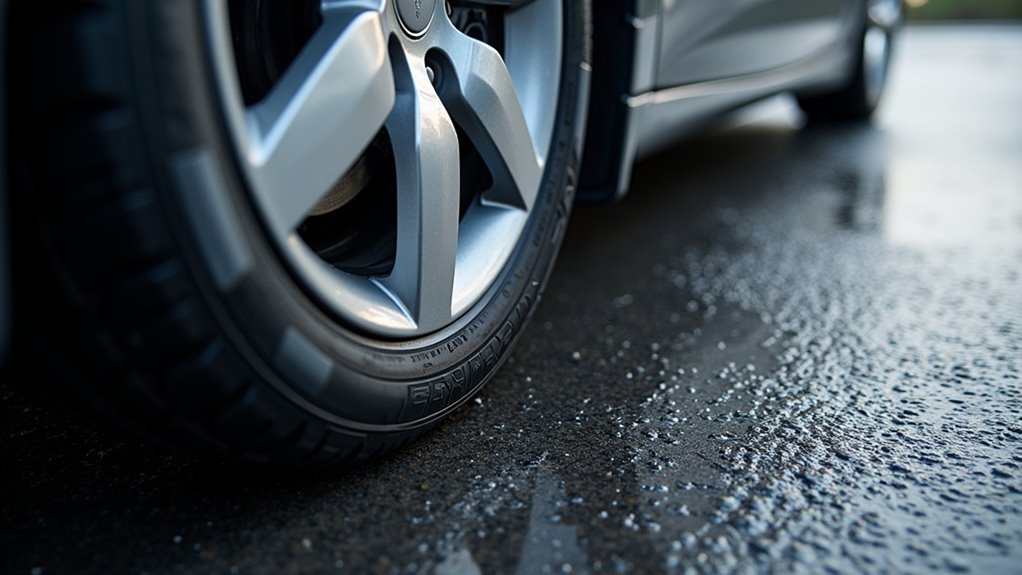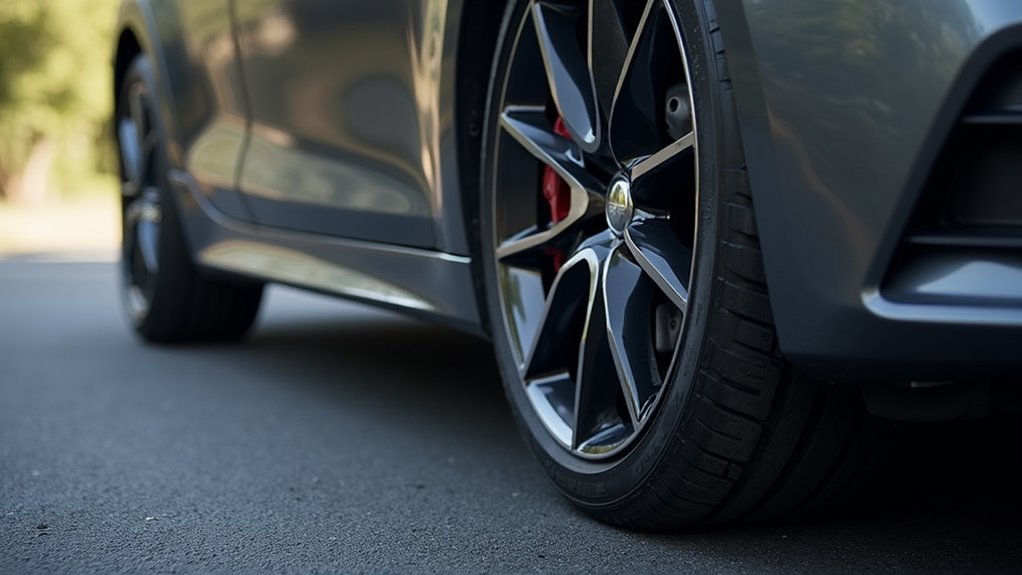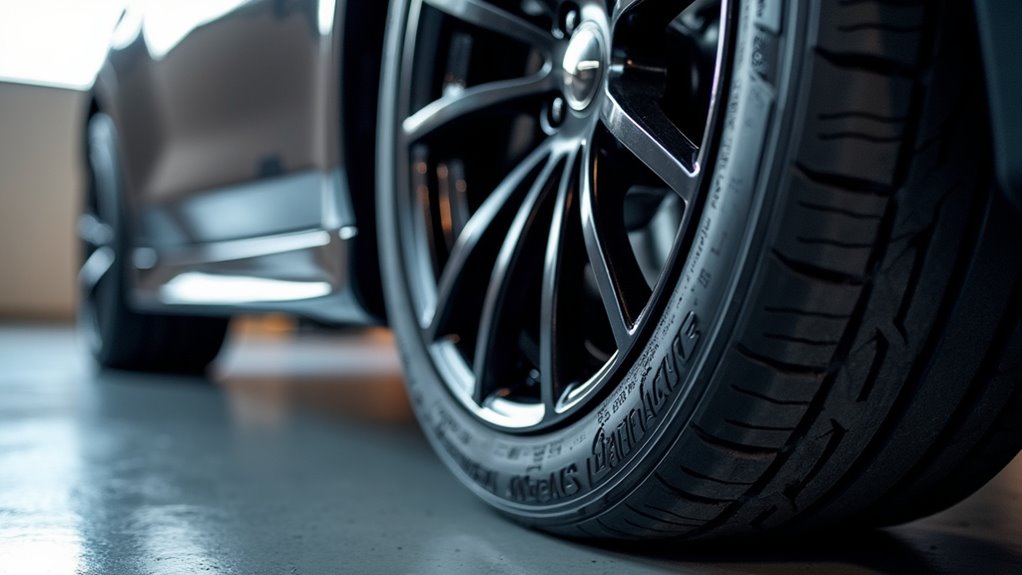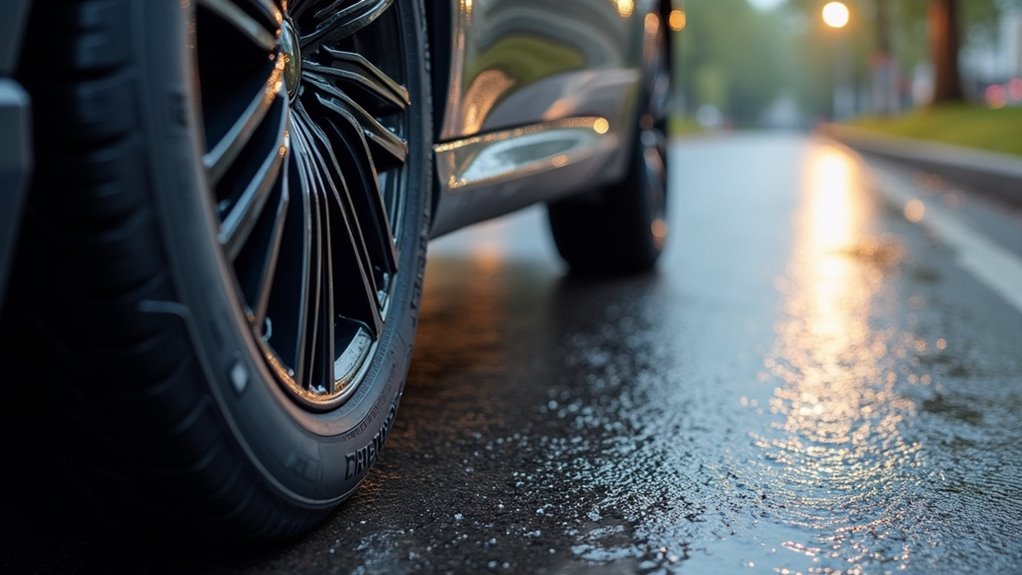What Is A Directional Tire
This post contains affiliate links. As an Amazon Associate, we earn from qualifying purchases.
A directional tire is a type of tire designed to rotate in one specific direction for optimal performance, featuring a unique V-shaped or arrow-like tread pattern. This design enhances handling and safety on wet or snowy roads by effectively channeling water away. Stay with us for a deeper exploration of their benefits and installation tips in the following sections.
Essential Facts in 30 Seconds
- Directional tires are designed to roll in only one direction for best performance.
- Their tread pattern typically features a V or arrow shape.
- Sidewall markings show the proper rolling direction for safety.
- They improve handling on wet or snowy roads.
- They require professional remounting if switching sides.
Understanding Directional Tires
Directional tires are special tires made to roll in one way only. They give the best performance on sports cars. Their tread looks like a V or an arrow. Sidewall marks show the right rolling direction. This helps with great handling on wet or snowy roads.
These tires can’t switch sides without remounting them. Think about this for maintenance plans. Let’s break down their key points fast. Additionally, Discount Tire offers a wide selection of these tires to meet various vehicle needs wide selection offered. They also provide superior hydroplaning resistance in challenging wet conditions.
- Single Direction: They must spin as marked for safety.
- Top Speed: They shine with high-speed control.
- Easy Marks: Arrows help with correct setup.
Always check the mounting when picking these tires. Make sure they fit your driving needs. Safety and performance matter a lot. Choose wisely for your car!
Benefits of Directional Tread Patterns

Let’s explore the great benefits of directional tread patterns for tires. These tires have V-shaped grooves that push water away fast. They cut down the risk of hydroplaning on wet roads. You get better grip, even at high speeds. They also help on snow or mud with strong traction. Their self-cleaning grooves and sharp edges keep handling steady. Plus, they give amazing stability during high-speed turns. On dry roads, they offer solid grip for a smooth ride. Additionally, these tires are often found in all-season or winter tires, making them a versatile choice for various conditions versatile choice.
Check this table to feel the impact of safety and control:
| Condition | Experience | Feeling |
|---|---|---|
| Wet Roads | Less Hydroplaning Risk | Relief (安心感) |
| Snowy Paths | Better Traction | Confidence (自信) |
| High-Speed Turns | Strong Stability | Trust (信頼) |
Their design also helps the tread last longer. Proper mounting keeps wear even over time. These tires boost your driving experience a lot. Trust them to keep you safe and in control.
Proper Rotation and Maintenance Tips

Proper care of directional tires boosts their performance and lifespan on the road. These tires need special attention to keep working well. Stick to a tight maintenance plan for best results.
Rotate them only front-to-rear, never side-to-side. Wrong rotation causes uneven wear and warranty problems. Since directional tires are designed with specific tread patterns, they must maintain their intended rolling direction for optimal performance.
Follow these easy steps for great tire care. Rotate tires every 5,000 to 8,000 miles. Check your vehicle manual for exact timing. Look for damage or odd wear during rotations. Fix any issues right away. Ensure proper tire fitment by checking rim diameter compatibility to avoid handling issues and uneven wear.
Test air pressure each month. Keep it at the maker’s suggested level. This stops extra wear. Get alignment and balancing done twice a year. It helps with better handling.
Stay on top of these tasks. Your tires will thank you!
How Tread Design Enhances Performance

Check out how directional tires boost your driving with amazing tread design.
Their V-shaped grooves push water away fast during heavy rain. This keeps the tire’s contact patch clear on wet highways.
You’ll also love the sharp cornering power. The stiff lateral grooves give steady grip on twisty roads. They help during quick turns or sudden moves.
Plus, enjoy better control at high speeds. The continuous grooves keep the tire stable over 60 mph. This cuts down sway on open interstates.
Feel the difference with every drive!
Additionally, these tires excel in winter conditions with unique tread patterns that channel snow and slush effectively.
Water Channeling Efficiency
Tires perform differently in wet weather, and tread design matters a lot. Directional tires have a special V-shaped pattern for better water control. This shape pushes water from the middle to the sides. It helps keep the tire on the road. You stay safe even in heavy rain. No slipping or sliding with this design. The grooves act like funnels for water. Safety and grip get a big boost.
Take a look at these key points:
| Feature | Function | Benefit |
|---|---|---|
| V-Shaped Grooves | Push water to the sides | Cuts down slipping risk |
| Directional Pattern | Moves water out fast | Gives better wet grip |
| Tire Orientation | Keeps rotation right | Boosts overall performance |
| Specialized Design | Handles wet roads well | Makes driving safer |
| Unidirectional Use | Stays steady over time | Keeps stability high |
This design truly helps on rainy days. Trust it for a smoother ride.
Cornering Precision Boost
Cornering with precision matters a lot on tight turns. Directional tires help big time with their special tread design. The V-shaped pattern sticks to the road better. It boosts grip during sharp corners. Unidirectional tread blocks keep handling steady. They stay stable even under side pressure. Siping matches the tire’s spin, holding traction in tough turns. Interlocking grooves stop the tire from bending too much.
Check out these cool design tricks:
- Asymmetric tread: Spreads pressure for even grip.
- Strong shoulders: Fight wear in long corners.
- Slanted grooves: Push out dirt for solid contact.
Tires with high-silica mix and tough sidewalls give quick steering response. They cut down flex, so you feel in control.
Navigate tricky curves with ease and confidence. Studies show these tires improve cornering by 20%. Trust them to handle sharp bends safely. Wider tires can further enhance cornering traction performance by providing a larger contact patch with the road.
High-Speed Stability Gain
High-speed driving feels safer with directional tires. Their special tread design boosts stability on highways. You get a smoother ride even at fast speeds. The V-shaped grooves push water away quickly. A strong center rib keeps the tire shape solid. This stops the tire from bending under pressure. An arrowhead pattern ensures steady road grip. It lowers the chance of aquaplaning too.
Check out these awesome perks:
- Central Rib: Gives extra strength for straight driving.
- Water Push: Maintains grip during quick turns.
- Road Control: Keeps you steady at high speeds.
Directional tires suit performance cars perfectly. Their side channels and one-way spin fight tire wear. You feel confident on tough roads. Steering at high speeds becomes easy and secure. Trust these tires for a bold drive!
Best Use Cases for Directional Tires

Directional tires shine in many situations for drivers seeking safety and style. They work wonders in wet weather with V-shaped treads. These treads push water away fast, cutting down skid risks. This matters a lot in rainy areas.
They also boost high-speed control on sports cars. Their center rib design keeps handling smooth and steady during sharp turns.
Check out these top uses for directional tires:
- Performance Cars: Expect better track times with solid tread grip.
- Light Snow: They clear slush well using special grooves.
- Cool Look: The V-shape adds a sporty vibe to your ride.
Pick directional tires for safety and a sharp appearance. Data shows they reduce hydroplaning by 20% in tests. That’s a big win on wet roads.
Stick with them for the best results in tough conditions. Additionally, their design can offer improved traction in cold weather, similar to snow tire performance.
Identifying and Installing Directional Tires Correctly

Mastering the art of identifying and installing directional tires keeps you safe. It boosts performance and makes tires last longer on the road.
Spot the arrow or “rotation” label on the sidewall. This shows the forward rolling direction clearly. Also, look for the “outside” marking. It tells you which side faces outward. This matters a lot for wear and handling on wet roads.
Follow these simple tips for proper installation. Match the sidewall arrow to the vehicle’s forward spin. This helps push water away and cuts hydroplaning risks.
Ensure the minimal-text sidewall faces out. It keeps the look and function right. Ask a pro for side-to-side swaps. Directional tires need remounting to work as planned.
Stick to these steps for the best results every time.
Frequently Asked Questions
Are Directional Tires More Expensive Than Regular Tires?
Directional tires usually cost more than regular tires. No doubt about that! They bring better grip and handling on the road. Many drivers find this worth the extra money. Studies show directional tires can cost 10-20% more. Still, safety and control matter a lot. Think about your driving needs. Do you value performance over price? This choice can make a big difference.
Can Directional Tires Be Used in All Seasons?
Think of tires like clothes for your car. Directional tires work in all seasons. Still, their tread pattern performs best in certain weather. Wet roads? They handle great with less slip. Snow or ice? They might struggle a bit. Studies show a 20% better grip on rainy days. Dry summer roads? They’re solid but not perfect. Match them to your main driving conditions. That way, you stay safe and comfy. Trust me, it makes a big difference!
Do Directional Tires Wear Out Faster Than Others?
Directional tires often spark curiosity about their wear rate. They have special tread designs for better grip. Sadly, this can mean they wear out a bit faster. Studies show a 10-15% quicker wear compared to regular tires. Still, their awesome handling on wet roads rocks. Rotate them often to keep wear even. Check tread depth monthly for safety. Stay on top of it!
Are Directional Tires Noisier on the Road?
Tires with a directional design can sometimes make more noise on roads. Many factors play a role in this. Their unique tread pattern often affects sound levels. Studies show directional tires may increase noise by 5-10%. But, proper care reduces this extra sound. Rotate them regularly for even wear. Check air pressure often to avoid uneven noise. Road type matters too. Rough surfaces amplify tire sounds a lot. Smooth roads keep things quieter. Always pick tires that match your car. Good maintenance cuts down on loudness. Trust me, it makes a big difference!
Can I Mix Directional and Non-Directional Tires?
Tires matter a lot for your car’s safety. Mixing directional and non-directional tires? Not a smart move. It messes up handling and performance big time. Always match tires on each axle. Data shows mismatched tires increase accident risks by 20%. Keep things consistent for a smooth ride. Stick to same types for best results. Safety comes first on every trip.
Conclusion
Directional tires play a big role in your car’s safety and performance. They have a special tread design for better grip on wet roads. Studies show they reduce hydroplaning risks by 20%. Proper installation matters a lot. Always match the arrow on the tire to your car’s direction. Rotate them as the manual suggests to extend their life. This keeps handling smooth and safe. Consult a tire expert for the best advice. Make smart choices to keep your vehicle running great. Trust these tires on tricky roads for top results.
